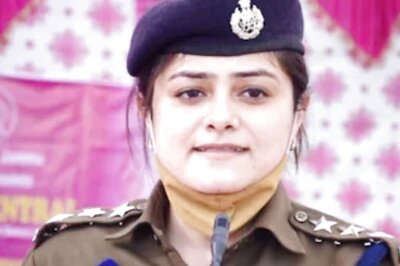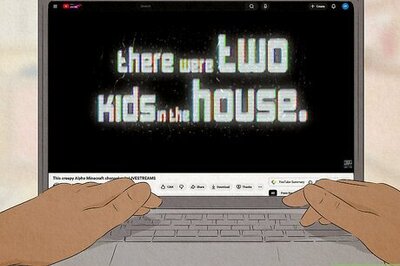
views
"We want justice! We want justice!"
I went to the protests at Raisina Hill expecting very little. Despite the anger over the recent, brutal gangrape of a 23-year-old by a group of six men, who also beat up her male friend, protests over women's violence in the Capital have been relatively small.
But the crowds walking up the Hill, towards the government offices of North and South Block, from India Gate are unusual. It's a young crowd - students, young men and women in their twenties, a smattering of slightly older women there to show their solidarity, and it's a large crowd, about a thousand strong at the Hill itself. There are two small knots representing student's political organisations, but otherwise, many of the people here today are drawn together only by their anger.
Many say it is their first protest, but "this time was too much". The women spill over with articulate indignation about how tired they are of being targets of violence - not free in the streets, not free at home, says one. The men talk about how they don't want to be seen in the same light as rapists; one young student talks about how helpless he feels when his women friends/ relatives are targeted. As more and more join the crowds, I realise that many of the students come from Faridabad, Ghaziabad, outside the insulated circle of South Delhi colleges. Almost all of them heard about the protest on Facebook and Twitter, or from friends - not through the mainstream media.
"Hang the rapists!" "Castrate Men Who Rape!"
Many of the protestors are volubly, enthusiastically for the death penalty, some demanding mob justice. "Give us those six men, and we'll show them what pain is like," says one lovely young girl, holding up a "Death To All Rapists" sign. Her friend breaks down when she talks about how she's followed the progress of the survivor of the recent gangrape in Delhi: the brutality of the rape (the rapists savaged the woman so badly with an iron rod that her intestines are permanently damaged) has become a kind of uber-nightmare for many. None of them have thought the implications of capital punishment though: this is a from-the-gut, emotional response.
Along with the "Death To The Rapist" chants, the "We Want Justice" refrain that runs through this morning's protests, there's also a swell of anger against the government and against politicians. Sheela Dikshit, Sonia Gandhi, the Home Minister-the crowd calls, again, and again, for them to come out and address people. They may not know exactly what they want-safer roads? An end to violence against women? Death to rapists?-but they really want someone to talk to them, anyway. "Come out from your safe offices, your safe cars, come out and see how we live," says one woman. It's picked up by many others.
"Don't kick it back! Don't let them blame us!"
The police attempts to disperse protestors thrice in the morning. I miss the first lathicharge/tear gassing, but the next two happen shortly afterwards - on what seems like scant provocation. Right at the front, holding the protestors back, a line of young boys and girls reminds everyone to keep it peaceful, to keep it down. "Say whatever you want to say, abuse as much as you want, but no violence," says a student who's as much of a leader as this spontaneous, leaderless protest has had. Earlier that morning, some members of the crowd smashed the window of a Delhi Police bus, and apparently that led to the first lathicharge and teargassing.
When four boys start pushing out another of the Delhi Police buses, other protestors immediately stop them. "Don't give them an excuse!" one calls, but it's too late. The bus has been rolled back into place. But the water cannon starts up and the teargas shells start bursting, as the police decide that's the best thing to do with a bunch of young protestors who're clearly trying to keep it peaceful. We cover our faces with shawls, hankies, and run for it, shells bursting around us. When one of the boys lobs a shell back, he's yelled at: "Don't kick it back! Don't let them blame us!"
The third tear-gassing is equally unwarranted: the police open up the barricades, leaving a tempting gap, and when protestors start to move in (and therefore technically towards Rashtrapati Bhavan), out come the cannons again and the teargas shells. But though the crowds disperse, they keep coming back. The mood has changed slightly. There are more calls of "Delhi Police Hai Hai!" and in a silent shift of tactics, the crowd does its best to bait the police. "Stones are being thrown at the police," one over-excited reporter says, and he has it wrong. What some of the protestors were throwing were coins, taunting the police: you don't do your job well enough to keep us safe, perhaps you will if we bribe you. Every so often, obeying some unspoken signal among themselves, the protestors amiably give the cops the finger.
Some boys climb up the lamp posts, holding up their slogans: Hang Rapists, Stop Violence, Respect Women. They're received with loud cheers, and then an even bigger cheer goes up when one young woman scales a lamppost. Soon, all five of the ornate iron lamp-posts in the park near Raisina Hill have been taken over by young women, sending out sincere if mixed messages. One of them, a fiery shouter of slogans, holds up bangles in the direction of the police, sending out a message that may be singularly unfeminist, but that is also very clear: you should wear these, like weak women, because you can't do your job, which makes you weak, like women. Seekers of metaphor and symbol would have a field day with this.
The protest stays calm and peaceful, settling down into a kind of rhythm, with separate knots performing their versions of homely street theatre, till about 2:30 pm. By that time, the sting of the teargas has left most of us, and I am recognising, with some surprise, just how safe I feel in this crowd, safer than I have ever felt in any public place in Delhi in decades.
Afternoon: a different crowd
But the crowd is changing, fast, and in unpleasant ways. The students, and their spontaneous protest, form a small wedge at the top of Raisina Hill, flanked by long lines of police and media. Behind them, swirling in eddies through the body of the protestors, are packs of activists, beginning to catch up to the televised, pulsing energy of this particular protest. I see cadres from all kinds of political parties, many of them, like the Shiv Sena, not known for their interest in women's rights or women's issues, here just to barrack the government and soak up some TV time. Loose knots of gawkers are beginning to stroll in, attracted by the tamasha - TV crews, out at India Gate on Saturday - and the composition begins to change, radically. If there were as many women as men during the first part of the day, now the back end of the protest, near India Gate, seems to have mostly men - few students, by the look of it.
However confused the protest of the morning was, it was also impressive in its own way - and moving, to see so many young people come out for a cause they felt strongly about, even more moving to see how caring they were of each other. "Do you need water?" the boys had asked, their own eyes streaming. "We have a little extra water," women had said, sharing what they had with the other girls who'd been teargassed. "Here, take my scarf, take my handkerchief, cover your face." All through the morning, there'd been that little ripple through the crowd: Is everyone all right? Is everyone safe?
By afternoon, that has changed. I'm at India Gate when the crump of the teargas shells starts up again. The cries of "We want justice!" still echo up Rajpath, but now groups of activists are performing for the TV cameras; the political cadres mug for their audiences; and back at the Hill, what started as a spontaneous gesture of solidarity from a bunch of unrelated young people with no agenda of their own has become yet another mixed, messy business. Not one politician, not one government official, came out on the ramparts of North or South Block to talk to them this morning; and if anyone does, later this evening, they'll be talking to a completely different crowd. I hope the curiosity of the idle won't last, and that other protestors from Delhi, who care about the issue more than about being on TV, will join this young, impassioned group.
In one of my favourite moments from the day: just after the first teargassing, as we tried to help a girl who was retching from the gas, her friend stood up and said, "So yeh hai Dilli Police ka motto, With You For You Gas You Always!" "Yaar," said another girl, "what a bunch of losers they are. Total losers." The refrain got picked up by the crowd. It may have been the first time in Indian history that a group of protestors responded to being teargassed by giving the police the bird, and chanting: "Losers, losers, tussi loser-log hai!"
It's a pity, because this bunch of protestors had something interesting about them. Their messages were mixed, and lacked the coherence you'd get from the average activist group, but their energy and will to at least try and make a change was unmistakeable. They have a lot to say for themselves, and though I hadn't planned to spend my Saturday morning on Raisina Hill, I'm glad I went.




















Comments
0 comment